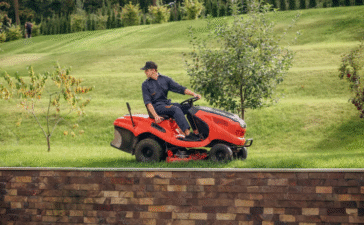A lush, healthy lawn doesn’t happen by accident. While we often focus on the power and brand of a lawn mower, the real star of the show is the blade. This single component is responsible for delivering a clean, precise cut that not only looks great but also promotes grass health. Understanding lawn mower blade types and performing proper blade maintenance are fundamental aspects of effective lawn care. This guide will walk you through everything you need to know about lawn mower blades. From their basic function to the different types available, you’ll learn how to choose, maintain, and troubleshoot blades for a picture-perfect lawn every time.
What Are Lawn Mower Blades?
Lawn mower blades are the cutting instruments attached to the underside of a rotary mower. As the engine runs, it spins the blade at a high velocity, creating a powerful cutting mechanism. A standard rotary blade has several key components:
- Cutting Edges: These are the sharpened sides of the blade responsible for slicing through grass.
- Center Hole: This is how the blade mounts to the mower’s crankshaft. Its size and shape must match the mower’s specifications perfectly.
- Blade Wings (or Lifts): These are the curved fins at the back of the blade that create airflow. This suction lifts the grass blades for an even cut and helps discharge the clippings.
When these components work together correctly, the blade delivers a clean, uniform cut across your entire lawn.
Types of Lawn Mower Blades
Not all blades are created equal. Different designs serve specific purposes, and choosing the right one depends on your lawn’s needs and how you want to handle grass clippings.
Standard Blades
Also known as 2-in-1 blades, standard mower blades are the most common type and come pre-installed on many new mowers. They are designed for general-purpose use, offering a moderate lift to either discharge clippings out the side or send them to a collection bag. They are a reliable choice for most residential lawns with average grass height.
High-Lift Blades
High-lift mower blades feature more pronounced, curved wings. This design generates powerful suction, which is excellent for lifting tall, dense grass for a clean cut. The strong upward airflow is especially effective at preventing clumps and propelling clippings into a bagging system. If you prefer to bag your clippings and want a pristine, debris-free finish, a high-lift blade is your best option.
Low-Lift Blades
In contrast, low-lift blades have smaller wings and create minimal airflow. This design is ideal for mowing in sandy or dusty conditions. By generating less suction, these blades kick up less dirt and debris, which protects the mower’s engine from damage and prevents a dusty mess. They are also suitable for side-discharging clippings without launching them too far.
Mulching Blades
Mulching blades, often called 3-in-1 blades, are designed to recycle clippings back into the lawn. They have a distinct curved shape with multiple cutting edges. As the blade spins, it cuts the grass, lifts the clippings into the mower deck, and then re-cuts them into fine particles. These tiny particles fall back onto the lawn, where they decompose and act as a natural, nitrogen-rich fertilizer. This is a cornerstone of organic lawn care.
Shredding Blades
Shredding blades, sometimes known as gator blades, are an aggressive variation of mulching blades. They have serrated teeth along the cutting edge that shred grass clippings and other debris, like leaves, into even finer pieces than a standard mulching blade. This makes them excellent for both mulching and bagging, as the finely shredded material decomposes faster or takes up less space in a collection bag.
How to Choose the Right Lawn Mower Blade
Selecting the right blade involves considering your lawn, your mower, and your personal preferences.
First, evaluate your lawn conditions. For a well-maintained lawn where you prefer to bag clippings, a high-lift blade is effective. If your area is dusty or sandy, a low-lift blade will protect your mower. For those looking to improve soil health and reduce waste, a mulching blade is the way to go.
Next, consider your grass type and the season. Thick, dense grasses benefit from the power of a high-lift blade, while mulching is especially beneficial during the main growing seasons.
Finally, you must ensure blade compatibility with your specific mower model.
Lawn Mower Blade Compatibility
Using an incompatible blade is not just ineffective; it’s dangerous. An improperly fitted blade can vibrate violently, damage the mower’s engine, or even detach during operation.
To ensure proper fit, you must check three specifications:
- Length: The blade must match the length specified by the manufacturer for your mower’s deck size. A blade that is too long will hit the deck, while one that is too short will leave uncut strips.
- Center Hole Pattern: The center hole must match your mower’s mounting bolt pattern. Common shapes include a 5-point star, a 6-point star, a “bow-tie” shape, or a simple circle.
- OEM vs. Aftermarket: OEM (Original Equipment Manufacturer) blades are made by your mower’s brand and guarantee a perfect fit. High-quality aftermarket blades can also be a good option, but you must double-check that the part number is cross-referenced to be compatible with your mower model.
Lawn Mower Blade Maintenance
Proper blade care is crucial for a healthy lawn and a long-lasting mower. Maintenance involves sharpening, cleaning, balancing, and eventually replacing the blade.
Sharpening Blades
A sharp blade cuts grass cleanly, which allows it to heal quickly. A dull blade rips and tears the grass, leaving ragged edges that turn brown and make the lawn susceptible to disease. As a general rule, you should sharpen your blade after every 20-25 hours of use or at least twice per mowing season. You can use a bench grinder, a hand file, or a sharpening attachment for your drill.
Cleaning Blades
After each use, clean your mower blades to remove caked-on grass, dirt, and moisture. This prevents rust and corrosion and helps maintain the blade’s balance. A wire brush or putty knife can easily scrape away debris.
Balancing Blades
An unbalanced blade will cause excessive vibration, which can damage the mower’s engine and create an uneven cut. After sharpening, always check the blade’s balance. You can do this by hanging the blade on a nail on the wall or using a dedicated blade balancer. If one side dips, file a small amount of metal from the heavier side until it sits level.
Replacing Blades
Even with great care, blades wear down. You should replace your blade if you notice large nicks, dents, thin areas, or cracks. A bent blade should be replaced immediately and never straightened, as this compromises its structural integrity.
Safety Tips for Handling Lawn Mower Blades
Always prioritize safety when working with mower blades. Before doing any maintenance, disconnect the spark plug to prevent the engine from accidentally starting. Wear thick, heavy-duty gloves to protect your hands from the sharp edges. When removing the blade, use a block of wood to brace it and prevent it from turning while you loosen the mounting nut.
Common Blade Issues and Troubleshooting
Even with regular maintenance, you may encounter problems.
- Dull Blades: The most common issue. If your lawn looks torn and has a brownish tint after mowing, your blade is dull and needs sharpening.
- Uneven Cuts: If your lawn has ridges or uncut strips, the blade may be unbalanced, bent, or installed incorrectly. Check the balance and inspect for damage.
- Rust and Corrosion: Surface rust can be removed with a wire brush. To prevent rust, always clean and dry your blades after use and consider applying a light coat of oil during off-season storage.
Also Check: “dewalt lawn mower“
Your Lawn’s Health Depends On Your Blade
Choosing the right lawn mower blade and keeping it in top condition are among the most important steps you can take for your lawn’s health and appearance. A sharp, balanced, and appropriate blade ensures a clean cut, promotes vigorous grass growth, and makes your mower operate more efficiently. Take the time to inspect your blades regularly and follow these maintenance guidelines your lawn will thank you for it.
Frequently Asked Questions
How often should I sharpen my lawn mower blades?
You should aim to sharpen your blades after every 20-25 hours of mowing time, or at least twice per season. If you notice your grass appears torn or frayed after cutting, it’s a clear sign your blade is dull and needs immediate attention.
What type of blade is best for mulching?
A dedicated mulching blade is best. These blades have a unique curved design and extra cutting surfaces that chop grass clippings into fine particles, allowing them to decompose and feed your lawn.
How can I tell if my lawn mower blade needs replacing?
Inspect your blade for significant signs of wear and tear. If you see large nicks, cracks, thin spots, or any bends in the blade, it’s time for a replacement. A severely damaged blade cannot be safely repaired and can harm your mower.
Can I use any blade on my mower?
No. You must use a blade that is compatible with your mower’s make and model. Check the required length and center hole pattern to ensure a safe and proper fit. Using an incompatible blade is dangerous and can damage your mower.
What’s the difference between high-lift and low-lift blades?
High-lift blades have deep curves that create strong suction, making them ideal for bagging clippings, especially in tall or thick grass. Low-lift blades have a flatter design that creates less airflow, which is better for sandy or dusty conditions as it prevents kicking up debris.












